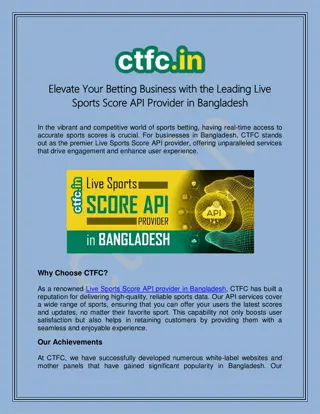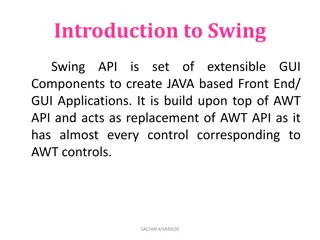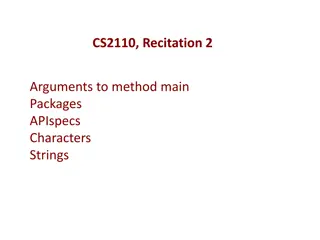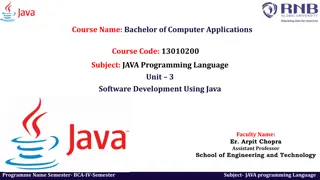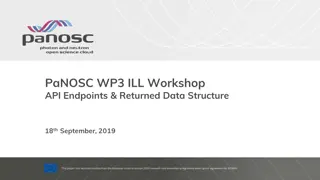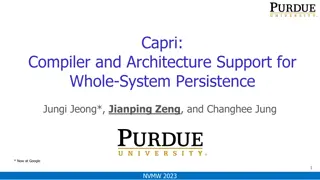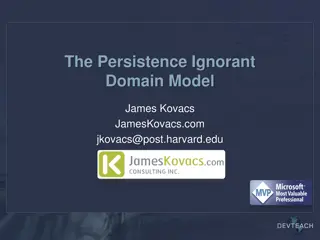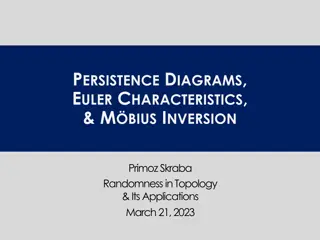Understanding Java Persistence API (JPA) for Data Management in Java Applications
Java Persistence API (JPA) is a specification that provides a framework for managing relational data in Java applications. It simplifies ORM solutions, offers vendor independence, and supports test-driven development with annotation-driven mapping.
Download Presentation

Please find below an Image/Link to download the presentation.
The content on the website is provided AS IS for your information and personal use only. It may not be sold, licensed, or shared on other websites without obtaining consent from the author. Download presentation by click this link. If you encounter any issues during the download, it is possible that the publisher has removed the file from their server.
E N D
Presentation Transcript
JPA JAVA API Specification Entity persistence model for EJB 3.0 POJO based framework for Java Persistence Management of Relational Data in JAVA applications javax.persistence package JPA 1.0 - 11th May 2006 JPA 2.1 - 22nd April 2013
Benefits of JPA JDBC was a low level API, It is simple, but error prone JPA leverages best ideas from ORM community Developers can choose between different implementations Vendor Independence
Goals of JPA Provides complete ORM solution for J2SE and J2EE applications Easy to use , no need to implement any framework interfaces or classes Facilitate test driven development Annotation Driven, No XML mapping needed
POJO Requirements Annotated with @Entity A lightweight persistence domain object Contains a persistent @Id field Should be a top level class class ,method or persistent field shouldn t be final Represents a table in a relational DB
JPA Annotations Annotations are from the package javax.persistence Annotation can be placed either on field or properties Field level access is preferred to prevent executing logic property level annotations are applied on getter methods Can t mix the style in inheritance hierarchy
Persistent Identifiers Entities must define an id field/fields corresponding to the database primary key The Id can either be simple or composite value Strategies @Id Single valued type Most common @IdClass -Maps multiple fields to table PK @EmbeddedId -Map Pk class to table PK Composite primary classes must Implement serializable Override equals() and hashCode()
@GeneratedValue Supports auto generated primary key value Strategies defined by GenerationType enum are GenerationType.AUTO GenerationType.IDENTITY GeneratioType.SEQUENCE GenerationType.TABLE
Commonly Used Annotations @Table and @Column Used to define name mappings between java objects and database table or column @Table applied at the persistent class level and @Column applied at the persistent field/property level
Commonly Used Annotations Contd @Temporal Used with java.uil.Date or java.util.Calendar to determine how value is persisted Values defined are TemporalType.TIME (java.sql.Time) TemporalType.DATE (java.sql.Date) TemporalType.TIMESTAMP (java.sql.Timestamp)
Commonly Used Annotations Contd @Enumerated Used to determine the strategy for persisting java enum values to database Values defined are EnumType.ORDINAL EnumType.STRING
Commonly Used Annotations Contd @Transient By default JPA assumes all fields are persistent Non persistent fields should be marked as transient or annotated with @Transient @Lob Used to persist values to BLOB /CLOB fields Often used with @Basic to lazy load value
EntityManagerFactory It gives an application-managed entity manager An EntityManagerFactory can have several Entity Managers Once an EntityManagerFactory is closed, all its entity managers are in the closed state.
EntityManager Handles O/R Mapping of Entities to the database Provides APIs inserting objects into database fetching objects from database synchronizing objects with database querying database Provides caching and coordinates transactional services
Persistence Unit A set of all entity classes managed by EntityManager instances. Defined in META-INF/persistence.xml. Identified with a unique name.
Entity A lightweight persistence domain object Represents a table in a relational DB Entity class annotated with javax.persistence.Entity A top level class Have a unique object identifier
JPA 2.1 Vendors JPA
ORM Converts data between incompatible type systems in object-oriented programming languages. Creates a "virtual object DB . Make RDBMS looks like ODBMS.
Hibernate A well known ORM tool. Most popular JPA API implementation. Maps the Relational Model in the database to the Object Model in Java.
CRUD Persist() Find() Merge() Remove()
Query Native SQL JPQL Criteria Query Named Query (XML & Annotation)
Query Native SQL Criteria Query JPQL
Associations One to One Unidirectional One to Many Many to One Bidirectional Many to Many A unidirectional relationship is valid in only in one direction. It has only an owning side. A bidirectional relationship is valid in both directions. It has both an owning side and an inverse (non-owning) side.
Associations B A A B a1 a2 a3 b1 b2 b3 b1 a1 b2 a2 b3 One to One b4 A B One to Many A b1 B a1 b2 a1 a2 a3 b1 a2 b3 b2 b4 Many to Many Many to one







